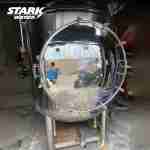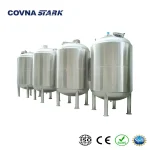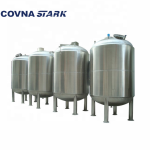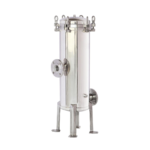Selecting the appropriate water tank size is crucial for ensuring adequate water storage, efficient space utilization, and meeting specific application needs. Whether you're storing water for residential, agricultural, or industrial purposes, understanding the dimensions and capacities of various water tanks will help you make an informed decision.
Why Water Tank Dimensions Matter
Water tank dimensions go beyond just height and width—they directly impact where and how you can install your tank, how much water it can hold, and what kind of foundation or support is required. Choosing the wrong size can lead to wasted space, insufficient capacity, or even structural issues over time.
- Space Efficiency: A compact tank with the right dimensions can fit into tight corners, rooftops, or narrow utility rooms, maximizing usable space.
- Water Requirements: Tank capacity must match daily consumption needs—especially for households, farms, or manufacturing facilities with high water demand.
- Structural Load: Taller tanks may exert higher pressure on the base, while wider tanks require broader support platforms.
- Compliance and Installation: Many municipalities or industrial sites have restrictions on tank size, height, or placement; choosing a standard-compliant dimension saves rework later.
Whether you're working with limited rooftop area or an open plot of land, understanding tank dimensions helps avoid costly mistakes and ensures long-term reliability.
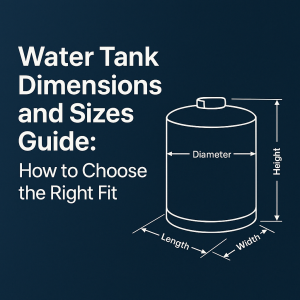
Common Water Tank Sizes and Dimensions
At STARK, we offer a wide range of stainless steel water tanks to meet global demands. Below are two sizing guides—one in Liters and one in US Gallons—to help you choose the right model based on your region and requirements.
➤ Metric Sizes (Liters)
| Capacity (Liters) | Approx. Dimensions (L × W × H, mm) | Recommended Use |
|---|---|---|
| 500L | 800 × 800 × 800 | Home gardens, drinking water storage, apartments |
| 1000L | 1000 × 1000 × 1000 | Small households, rooftop backup water |
| 2000L | 1200 × 1200 × 1200 | Villas, commercial water tanks |
| 5000L | 1600 × 1600 × 1900 | Farms, apartment buildings, irrigation |
| 10,000L | 2000 × 2000 × 2600 | Hospitals, school buildings, municipal use |
➤ US Sizes (Gallons)
| Capacity (US Gallons) | Approx. Dimensions (L × W × H, mm) | Recommended Use |
|---|---|---|
| 100 gal | 700 × 700 × 700 | Household water storage, emergency supply |
| 250 gal | 900 × 900 × 900 | Gardening, small office use |
| 500 gal | 1150 × 1150 × 1150 | Medium-sized home or cabin |
| 1000 gal | 1400 × 1400 × 1500 | Small business, shared building supply |
| 2000 gal | 1800 × 1800 × 2000 | Large commercial, hotel, or agriculture |
Dimensions are approximate and may vary based on outlet positions, insulation, or tank shape (square or cylindrical). For custom gallon or liter configurations, contact us for tailored solutions.
How to Choose the Right Water Tank Size
Choosing the correct water tank size is not just about volume—it's about selecting the optimal tank that matches your usage habits, site conditions, water quality, and long-term goals. Below is a comprehensive guide to help you choose confidently:
1. Estimate Daily Water Usage
Start by estimating your daily water demand. Use the following guidelines:
- Domestic Use: 100–150 liters (26–40 gallons) per person per day
- Irrigation/Farming: 15–25 liters per square meter of cultivated land per day
- Hotels/Restaurants: 150–300 liters per guest per day, depending on service level
- Factory Cooling or Processing: Varies by industry—consult with your operations team
Example: A family of 4 needing 3-day backup = 4 × 150 × 3 = 1,800L → choose at least a 2000L tank.
2. Clarify the Application
Not all tanks serve the same purpose. Ask yourself:
- Is the water for drinking? Choose stainless steel with food-grade welds and sealed design
- Is it for toilet flushing, gardening, or industrial use? Focus on capacity rather than surface polish
- Will the tank be exposed to chemicals or salty water? Consider upgrading to SUS316L steel for corrosion resistance
The better the match between your use case and tank material/specs, the longer your system will last.
3. Evaluate Installation Site Conditions
Carefully measure and assess your site:
- Is space limited? Choose a vertical design
- Is the rooftop or platform structurally rated? Check load-bearing capacity before choosing a heavy tank
- Is drainage available? Ensure bottom outlet aligns with your drainage plan
- Is inspection access possible? Leave space around the tank for cleaning or vent/filter maintenance
4. Consider Climate and Location
Geographic and weather factors affect ideal tank size and configuration:
- Hot regions: Consider insulated tanks to prevent water overheating
- Cold climates: Use jacketed tanks or heated enclosures to avoid freezing
- Remote/dry areas: Choose the largest tank that can be delivered to your location efficiently
5. Plan for Future Expansion
It’s often wiser to buy slightly larger than needed. Water usage tends to increase over time—children grow up, businesses expand, climate changes. A 20% margin in capacity provides peace of mind and flexibility.
Still unsure? Contact the STARK team to get a customized size recommendation based on your specific usage and project site.
Why Choose STARK Water Tanks?
STARK specializes in the design and manufacturing of stainless steel water tanks tailored for residential, commercial, and industrial applications worldwide. Whether you need a compact rooftop unit or a 10,000-liter ground-based tank, we deliver performance, durability, and long-term value.
- Wide Range of Sizes: From 500L to 10,000L (or 100 to 2,600 gallons), we offer standard and custom capacities to meet any requirement.
- Reliable Materials: All tanks are made from SUS304 or SUS316L stainless steel, ensuring high corrosion resistance and hygiene compliance.
- Tailored Configuration: Choose inlet/outlet positions, manholes, insulation layers, and level indicators based on your project needs.
- Global Delivery: We ship worldwide with professional support, and provide dimensional drawings and consultation services before purchase.
Need help choosing the right tank size or design? Contact the STARK team today for expert advice, technical drawings, and customized water tank solutions.

